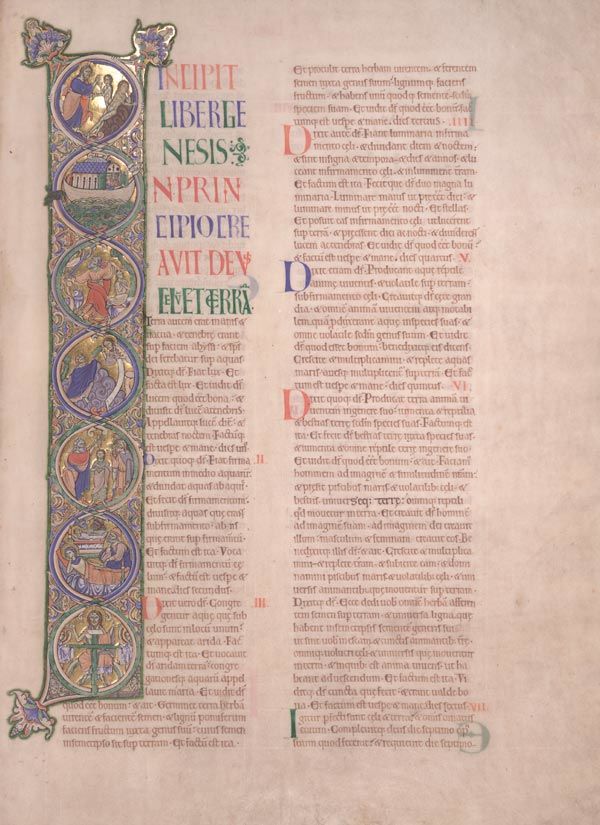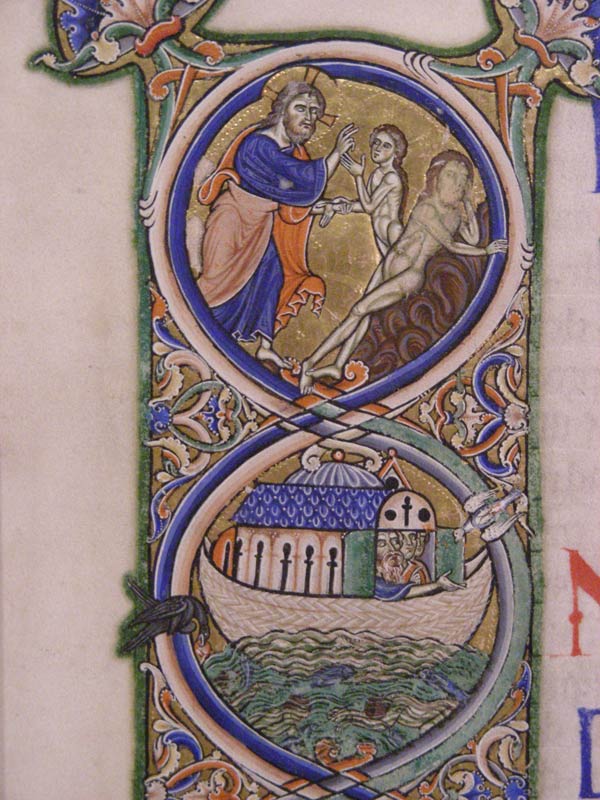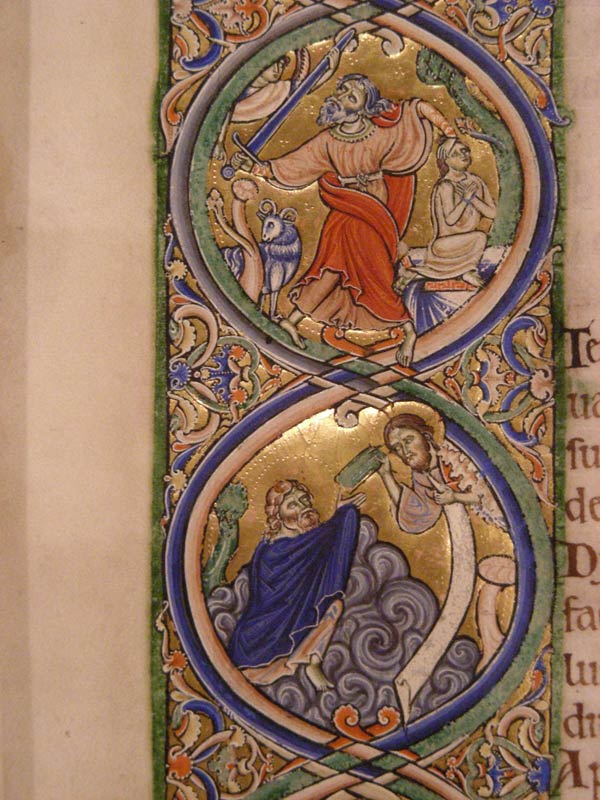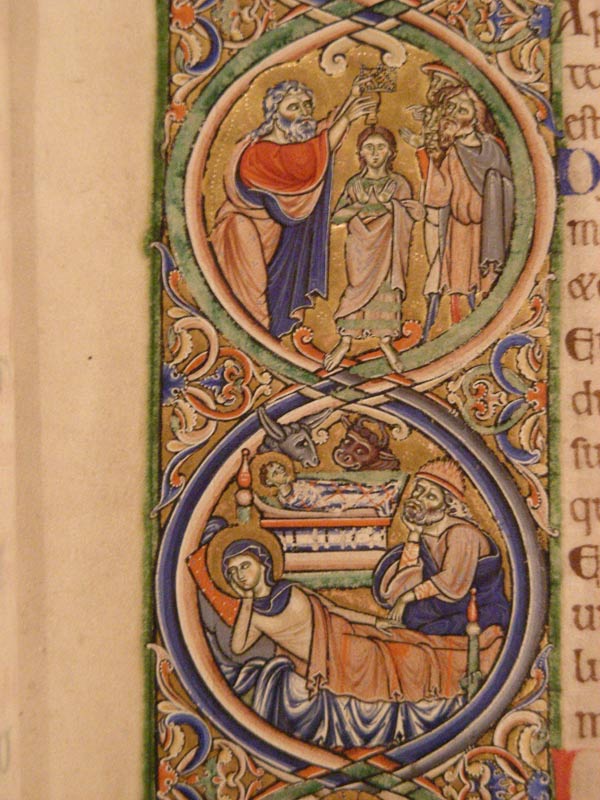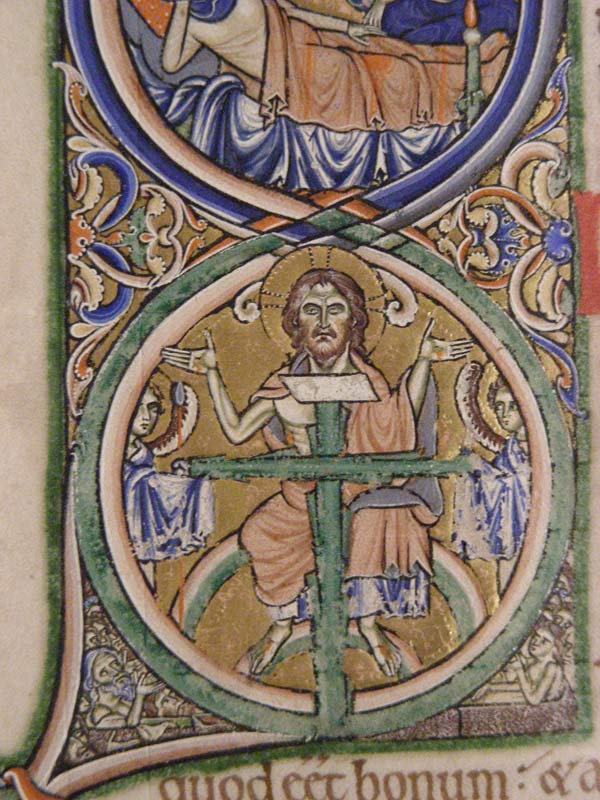The Winchester Bible: Opening for the Book of Genesis: In Principio (5r), ca 1150–80. Made in Winchester, England. Tempera and gold leaf on parchment; 23 9/16 x 16 9/16 x 2 3/8 in. (59.9 x 42.1 x 6.1 cm). Opening: 23 9/16 x 27 1/2 in. (59.9 x 69.9 cm). Lent by the Chapter of Winchester Cathedral
Each book of the Winchester Bible, on view through March 8, begins with an oversized, decorated first letter called an initial. The initials' decorations vary from fancy foliate designs to narrative scenes framed within the letter itself. The initial prefacing the Winchester Bible's book of Genesis is especially complex in its composition because it serves an extraordinary purpose: to encompass the entire Bible—and with it the entire history of salvation—in a single composition. This ambitious endeavor presents a way of thinking about the Bible that would have been second nature to its original readers, a community of Benedictine monks.
The Latin text of the book of Genesis begins with "In principio" (in the beginning) to introduce the story of creation. In the Winchester Bible, the elongated shaft of the letter I extends almost the full length of the page (each page measures approximately 23 x 15 3/4 inches). Within this tall, columnar letter are seven roundels formed from a series of interwoven bands. Within each roundel is a different biblical image.
Detail from the Genesis initial showing God creating Eve and Noah's ark.
The first roundel (pictured above) shows God creating Eve. Here God, depicted as Christ, greets Eve with a gesture of blessing as she emerges from Adam's side. Below this scene, we see an image of Noah's ark, floating on the vast sea created by forty days and forty nights of rain, and Noah receiving the dove carrying an olive branch in its beak. Those with keen eyesight will note the outline of bodies in the water—the victims of the flood. Also depicted is the raven sent out by Noah that did not return. It is seen devouring the bodies of those who perished.
The third scene (pictured below) shows the patriarch Abraham about to sacrifice his son Isaac at God's command. We encounter Abraham just at the moment an angel of the Lord intervenes to prevent him from killing his son. His body twisted, his sword still upraised, Abraham turns to look at the angel behind him. At his side is the ram that will replace his son as a sacrifice.
Those familiar with the books of the Bible will immediately notice a shift in the fourth image (below Abraham and Issac). While the previous three scenes are all described in Genesis, the fourth one shows an episode from Exodus: Moses receiving the Ten Commandments from God on Mount Sinai. Again, God is depicted in the familiar form of Christ as he hands over a pair of tablets, which Moses reaches out to receive with one hand veiled reverentially. The fifth scene moves forward yet again to the first book of Kings and the anointing of David as king by Samuel (a scene also depicted in the Winchester Bible's Morgan Leaf).
Detail from the Genesis initial showing the Sacrifice of Isaac by Abraham and Moses receiving the Tablets of the Law.
The last two scenes (pictured below) come from the Gospels and the Apocalypse of the New Testament respectively. The Nativity shows Mary resting with Joseph at her side, while the infant Christ lies swaddled in a cradle, accompanied by the ox and the ass. The last roundel depicts Christ in Majesty, fulfilling his role as judge at the end of time. He sits in heaven, on a double rainbow, and floating before him is a cross depicted as a green, living tree. The wounds of the Crucifixion are displayed on his hands, feet, and right side. He is flanked on either side by an angel.
Detail from the Genesis initial showing Samuel anointing David and the Nativity.
Detail from the Genesis initial showing Christ in Majesty.
In gathering key images from the entire Bible, the Genesis initial sets the stage for what is to follow. The selection is more a commentary on the Bible's contents than a summary of them. Medieval Christians understood the Old and New Testaments to form two halves of a single narrative. The first half prepared the world for the second, which would result in the redemption of humanity. Moreover, the New Testament would supersede the Old Testament. Proceeding from this core belief, Christian theologians drew links between the Old Testament and the New Testament. They believed the prophecies of the Old Testament heralded the arrival of Christ in the New Testament, and they understood the personages and events of the Old Testament to prefigure those of the New Testament.
With this in mind, it is possible to interpret the individual roundels of the Genesis initial as participants in a dialogue about the nature of the Bible. There are many connections to be drawn. For example, Abraham's attempted sacrifice of his son Isaac was believed to prefigure God's sacrifice of his own son on the Cross. In the initial, Abraham's willingness to offer up his son echoes in the cross of the Crucifixion included in the image of Christ in Majesty. (The tree-like appearance of the cross also alludes to the fruit tree from which Adam and Eve ate, resulting in their expulsion from the Garden of Eden.)
The initial's image of Moses receiving the Ten Commandments represents what medieval Christians saw as the "old law." This was understood to have been superseded by the "new law" with the birth of Jesus, represented in the initial's Nativity scene. Additionally, because King David was seen as a precursor of Christ, the image of his anointing in the initial resonates with the regal depiction of Christ in Majesty. Throughout, the portrayal of God in the guise of his son Christ clearly links the Old and New Testaments.
The Genesis initial thus reveals a standard perspective from which medieval Christians studied the Bible. Though most of the original readers of the Winchester Bible may have only viewed this deluxe manuscript on select occasions, it is easy to imagine many pairs of monastic eyes running up and down this single letter, observing new parallels and drawing new conclusions each time they had a chance to look at it. The Genesis initial thus encapsulates an entire way of thinking that dominated religious life. To examine it today is to glimpse inside the medieval monastic mind—a powerful exercise in understanding the past.
